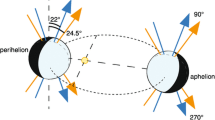Abstract.
The National Center for Atmospheric Research-Community Climate System Model (NCAR-CCSM) is used in a coupled atmosphere–ocean–sea-ice simulation of the Last Glacial Maximum (LGM, around 21,000 years ago) climate. In the tropics, the simulation shows a moderate cooling of 3 °C over land and 2 °C in the ocean in zonal average. This cooling is about 1 °C cooler than the CLIMAP sea surface temperatures (SSTs) but consistent with recent estimates of both land and sea surface temperature changes. Subtropical waters are cooled by 2–2.5 °C, also in agreement with recent estimates. The simulated oceanic thermohaline circulation at the LGM is not only shallower but also weaker than the modern with a migration of deep-water formation site in the North Atlantic as suggested by the paleoceanographic evidences. The simulated northward flow of Antarctic Bottom Water (AABW) is enhanced. These deep circulation changes are attributable to the increased surface density flux in the Southern Ocean caused by sea-ice expansion at the LGM. Both the Gulf Stream and the Kuroshio are intensified due to the overall increase of wind stress over the subtropical oceans. The intensified zonal wind stress and southward shift of its maximum in the Southern Ocean effectively enhances the transport of the Antarctic Circumpolar Current (ACC) by more than 50%. Simulated SSTs are lowered by up to 8 °C in the midlatitudes. Simulated conditions in the North Atlantic are warmer and with less sea-ice than indicated by CLIMAP again, in agreement with more recent estimates. The increased meridional SST gradient at the LGM results in an enhanced Hadley Circulation and increased midlatitude storm track precipitation. The increased baroclinic storm activity also intensifies the meridional atmospheric heat transport. A sensitivity experiment shows that about half of the simulated tropical cooling at the LGM originates from reduced atmospheric concentrations of greenhouse gases.
Similar content being viewed by others

Author information
Authors and Affiliations
Additional information
Electronic Publication
Rights and permissions
About this article
Cite this article
Shin, .SI., Liu, .Z., Otto-Bliesner, .B. et al. A Simulation of the Last Glacial Maximum climate using the NCAR-CCSM. Climate Dynamics 20, 127–151 (2003). https://doi.org/10.1007/s00382-002-0260-x
Received:
Accepted:
Issue Date:
DOI: https://doi.org/10.1007/s00382-002-0260-x



